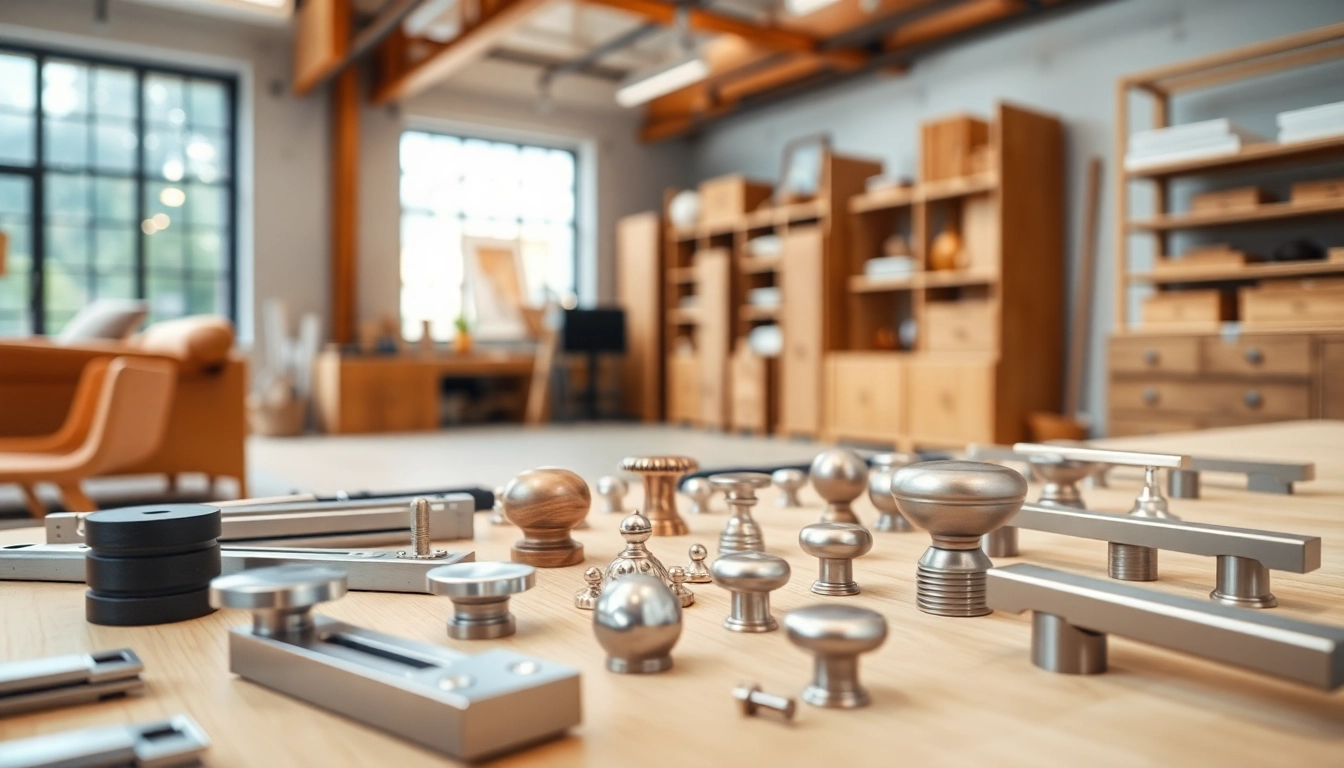Understanding the Role of Furniture Hardware Manufacturers
When it comes to furniture, the aesthetics can capture attention, but the functionality lies in the details of hardware components. Furniture hardware manufacturers play an essential role in the creation and maintenance of functional, stylish furniture. These manufacturers produce a variety of components essential to furniture assembly, including hinges, slides, knobs, and pulls. In this article, we will delve deep into the world of furniture hardware, exploring the importance of quality, key products, and innovations shaping the industry.
What is Furniture Hardware?
Furniture hardware encompasses a range of components used to achieve functionality and enhance the visual appeal of furniture. These components include:
- Knobs and Pulls: These are used for opening drawers and cabinets, available in various styles, materials, and finishes.
- Hinges: Essential for doors and lids, hinges allow for smooth operation and come in concealed and visible designs.
- Slides: Drawer slides enable easy access to contents by allowing drawers to glide in and out smoothly.
- Brackets and Supports: Used to strengthen furniture structure, particularly in shelving and cabinetry.
- Locks: These provide security for cabinets and storage units, crucial for safety, particularly in commercial settings.
Overall, furniture hardware contributes to both practicality and the integrity of the furniture design.
The Importance of Quality in Hardware
The quality of furniture hardware is paramount. High-quality components ensure durability, preventing wear and tear over time. Poor-quality hardware can lead to malfunctions, such as sticking drawers or misaligned cabinet doors, which may require costly repairs or replacements. In contrast, investing in quality hardware can enhance the longevity and aesthetic of the furniture.
Moreover, reputable manufacturers often stand by their products with warranties, underlining their commitment to quality. This assurance allows consumers and manufacturers alike to rely on their hardware choices, minimizing the likelihood of issues down the road.
Market Overview: Leading Manufacturers
Several leading manufacturers dominate the furniture hardware market. These firms stand out for their high-quality products, innovative designs, and comprehensive ranges:
- Top Knobs: Known for a wide selection of cabinet knobs and pulls that cater to diverse aesthetics, from modern to classical styles.
- Rockler: A prominent player in offering solutions for cabinet hardware needs, including drawer slides, hinges, and project hardware.
- Furnica: Focuses on providing a comprehensive range of furniture accessories, ensuring that your project has access to the latest in hardware technology.
- Richelieu: This manufacturer leads in specialized hardware solutions with an extensive catalog of avant-garde designs for unique installations.
- Häfele: A global market leader developing hardware solutions tailored for various living environments, from home to commercial settings.
These manufacturers are trusted sources for builders, designers, and DIY enthusiasts who seek reliable hardware solutions.
Key Products Offered by Furniture Hardware Manufacturers
Types of Hardware: Cabinet Knobs and Pulls
Cabinet knobs and pulls are perhaps the most visible elements of furniture hardware, playing a crucial role in both functionality and aesthetics. These components come in countless designs, materials, and finishes. For example:
- Materials: Common materials for knobs and pulls include metal, plastic, wood, and glass, each offering a distinct look and feel.
- Finishes: Finishes can range from polished chrome to antique brass, allowing homeowners and designers to match décor styles effectively.
- Design Styles: From sleek modern designs to ornate vintage styles, the style of knobs and pulls can dramatically influence the overall appearance of cabinetry.
Choosing the right knobs and pulls can elevate the appearance of furniture and tie various elements of a room together.
Functional Hardware: Hinges and Slides
Hinges and slides serve a critical functional role. They are necessary for the smooth operation of doors and drawers, impacting overall user experience. The types of hinges and slides vary significantly:
- Hinges: These can include concealed hinges for a clean look, piano hinges for continuous support, and top-mounted hinges on cabinet doors.
- Drawer Slides: Options include side-mount and under-mount slides, with some providing soft-close mechanisms that prevent slamming.
Selecting the appropriate type of hinges and slides can make a significant difference in furniture function, ensuring that components operate smoothly while also sealing appropriately when closed.
Trendy Accessories: Customization Options
Customization options are increasingly popular among furniture hardware manufacturers. Many offer personalized solutions that enhance both functionality and style. This includes:
- Custom Finishes: Some manufacturers allow clients to select unique finishes for their hardware, creating pieces that perfectly match design preferences.
- Unique Shapes: Certain suppliers create bespoke shapes and designs, contributing to one-of-a-kind furniture pieces.
- Personalized Engravings: Offering customized engravings allows clients to add personal touches to their hardware, making furniture feel unique.
These customization options reflect the growing trend of personalization in home décor, allowing consumers to control their furniture’s aesthetics and functionality.
Choosing the Right Furniture Hardware for Your Needs
Factors to Consider: Aesthetic vs. Functionality
When choosing furniture hardware, striking the right balance between aesthetics and functionality is critical. Here are some factors to keep in mind:
- Aesthetic Appeal: Consider how the hardware will complement the furniture and existing décor. The design of knobs and pulls should enhance the overall look, not detract from it.
- Durability: Quality hardware must withstand regular use, so materials should be durable enough to prevent wear.
- Functionality: Ensure the hardware performs its intended function smoothly and efficiently. For example, select soft-close slides if users want an upgraded experience.
Finding a product that marries function with form can greatly enhance the overall feel and usability of furniture designs.
Best Practices for Selection and Pairing
To effectively select and pair furniture hardware, consider the following best practices:
- Match Styles: Ensure that the style of the hardware matches the furniture design. Modern furniture often pairs best with sleek, minimal hardware, while traditional designs benefit from ornate choices.
- Color Coordination: Match the finishes of hardware with other elements in the room for a cohesive and harmonious look.
- Size Matters: Ensure the scale of the hardware complements the piece. Oversized knobs on small drawers can appear awkward, whereas tiny hardware on large pieces may be underwhelming.
By keeping these best practices in mind, one can create a visually pleasing yet functional environment.
Understanding Sizing and Compatibility
It’s vital to understand sizing and compatibility before making hardware selections. Key considerations include:
- Standard Measurements: Familiarize yourself with standard sizes for screws, spacing, and bore hole depth to ensure proper installation.
- Compatibility with Furniture: Ensure the hardware is suitable for the type of furniture and its style to avoid any mismatches.
- Adjustability: Some hardware allows for adjustments, which can be beneficial for ensuring a proper fit in various applications.
Taking the time to understand these components will lead to successful installations and satisfied end-users.
Innovations in Furniture Hardware Manufacturing
Emerging Trends in Designs and Materials
The furniture hardware industry is witnessing exciting innovations. Some of the prevalent trends include:
- Eco-Friendly Materials: Manufacturers are increasingly considering sustainable materials such as bamboo, recycled metals, and biodegradable plastics for hardware production.
- Smart Hardware: Technological advancements have given rise to smart hardware options that include sensors and automation for enhanced functionality.
- Minimalist Designs: Contemporary trends favor minimalistic hardware that is sleek and unobtrusive, often with integrated functionalities.
These trends reflect evolving consumer priorities and innovative approaches to design in furniture hardware.
Technological Advancements in Manufacturing
Manufacturers are increasingly leveraging technology for more efficient production processes. Key advancements include:
- 3D Printing: This technology allows for rapid prototyping and the ability to create complex designs that might not be feasible with traditional manufacturing methods.
- Computer-Aided Design (CAD): CAD software enables precise designs, reducing errors and improving overall product quality.
- Automation: Automated processes enhance efficiency, reduce costs, and ensure consistency in production lines.
These advancements not only streamline production but also enhance the capacity for innovation within the market.
Eco-Friendly Practices among Manufacturers
Many manufacturers are now prioritizing sustainability in their operations, employing various eco-friendly practices:
- Material Sourcing: Companies are sourcing sustainable materials, such as FSC-certified wood and recyclable metals, to minimize environmental impact.
- Waste Reduction: Implementing lean manufacturing practices helps reduce waste produced during the hardware manufacturing process.
- Energy Efficiency: Factories are adopting energy-efficient practices and equipment to lower their carbon footprint.
By embracing eco-friendly practices, manufacturers are not only appealing to environmentally conscious consumers but also contributing to a more sustainable planet.
Maximizing Your Investment in Furniture Hardware
Tips for Proper Installation and Maintenance
Proper installation and maintenance are crucial for maximizing your investment in furniture hardware:
- Follow Manufacturer Instructions: Always adhere to installation guidelines provided by the manufacturer to avoid product failure.
- Regular Maintenance: Periodic checks and timely lubrication of moving parts can extend the lifespan of hardware components.
- Handle with Care: Educate users on proper use, especially for innovative hardware, to prevent unintentional damage.
By investing time in careful installation and maintenance, one can ensure that hardware remains functional and visually appealing over time.
Understanding Warranties and Lifespan
Understanding warranty terms is vital when purchasing hardware. Different manufacturers may offer varying warranty durations and conditions:
- Standard Warranty: Many hardware products come with a standard warranty, ensuring that replacements or repairs are facilitated if defects arise within a specified period.
- Extended Warranty Options: Some manufacturers may provide options for extended warranties for an additional fee, offering greater peace of mind.
- Product Lifespan: The expected lifespan can vary based on the hardware type and material quality – knowing this helps in budgeting for future replacements.
By being aware of warranty terms and expected lifespan, consumers can make informed decisions and foster long-term relationships with suppliers.
Balancing Cost and Quality
When it comes to furniture hardware, a common dilemma is balancing cost with quality. Here are some practical tips:
- Assess Your Needs: Determine which pieces of hardware will undergo frequent use and prioritize quality for those items.
- Research Brands: Explore various brands to find manufacturer reputations, reviews, and warranty terms that can justify the price difference.
- Invest Wisely: Long-term savings can often result from investing in slightly more expensive but higher-quality hardware due to reduced maintenance and replacement costs.
Ultimately, being knowledgeable about the options available can help create a balanced investment in furniture hardware.



